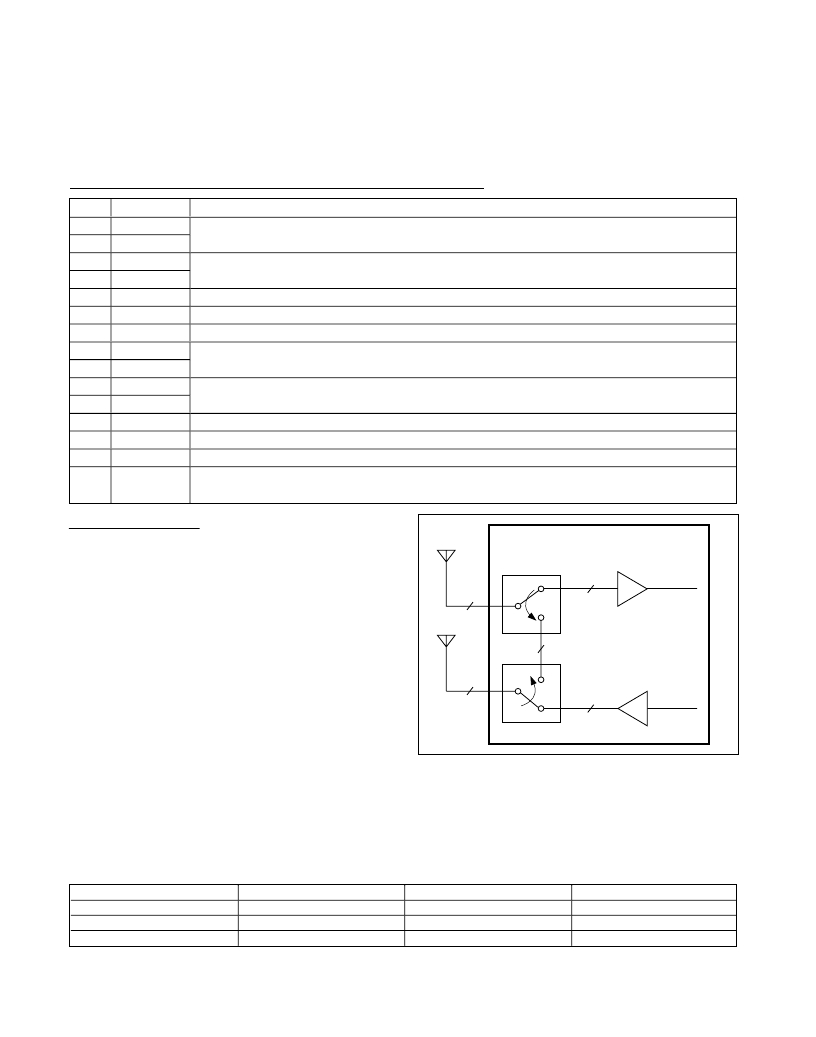- 您现在的位置:买卖IC网 > Sheet目录473 > MAX2830EVKIT+ (Maxim Integrated)KIT EVAL FOR MAX2830

MAX2830
2.4GHz to 2.5GHz 802.11g/b RF Transceiver, PA,
and Rx/Tx/Antenna Diversity Switch
Pin Description (continued)
PIN
35
36
37
38
39
40
41
42
43
44
45
46
47
48
—
NAME
RXBBQ-
RXBBQ+
RXBBI-
RXBBI+
V CCRXVGA
RXHP
V CCRXFL
TXBBQ-
TXBBQ+
TXBBI-
TXBBI+
V CCRXMX
ANTSEL
RXTX
EP
FUNCTION
Receiver Baseband Q-Channel Differential Outputs. In TX calibration mode, these pins are the LO leakage
and sideband detector outputs.
Receiver Baseband I-Channel Differential Outputs. In TX calibration mode, these pins are the LO leakage
and sideband detector outputs.
Receiver VGA Supply Voltage
Receiver Baseband AC-Coupling High-Pass Corner Frequency Control Logic Input
Receiver Baseband Filter Supply Voltage
Transmitter Baseband I-Channel Differential Inputs
Transmitter Baseband Q-Channel Differential Inputs
Receiver Downconverters Supply Voltage
Antenna Selection Logic Input. See Table 1 for operation
Rx/Tx Mode Control Logic Input. See Table 32 for operating modes.
Exposed Paddle. Connect to the ground plane with multiple vias for proper operation and heat dissipation.
Do not share with any other pin grounds and bypass capacitors' ground.
Detailed Description
The MAX2830 single-chip, low-power, direct conversion,
zero-IF transceiver is designed to support 802.11g/b
MAX2830
applications operating in the 2.4GHz to 2.5GHz band.
The fully integrated transceivers include a receive path,
transmit path, VCO, sigma-delta fractional-N synthesizer,
crystal oscillator, RSSI, PA power detector, temperature
sensor, Rx and Tx I/Q error-detection circuitry, baseband-
control interface, linear power amplifier, and an Rx/Tx
antenna diversity switch. The only additional components
required to implement a complete radio front-end solution
are a crystal, a pair of baluns, a BPF, and a small number
of passive components (RCs, no inductors required).
Rx/Tx and Antenna Diversity Switches
The MAX2830 integrates an Rx/Tx switch and an anten-
na diversity switch before the receiver and after the
2
ANT1
2
ANT2
2
2
2
LNA
PA
power amplifier. See Figure 1 for a block diagram of the
switches. The receiver and transmitter enable pin
(RXTX) and the antenna selection pin (ANTSEL) deter-
mine which ports (ANT1 or ANT2) the receiver or trans-
mitter is connected to. See Table 1 for the Rx/Tx and
antenna diversity switches truth table. When RXTX = 0
Figure 1. Simplified Rx/Tx and Antenna Diversity Switch Structure
(receive mode) and ANTSEL = 0, the switch provides a
low-insertion loss path (main) between the ANT1 port
(pins 4 and 5) and the receiver. When RXTX = 0
(receive mode) and ANTSEL = 1, the switch provides
Table 1. Rx/Tx and Antenna Diversity Switches Operation
20
RXTX
0
0
1
ANTSEL
0
1
X
MODE
Rx (main)
Rx (diversity)
Tx
ANTENNA
Ant1_
Ant2_
Ant2_
Maxim Integrated
发布紧急采购,3分钟左右您将得到回复。
相关PDF资料
MAX2831EVKIT+
KIT EVAL FOR MAX2831
MAX2837EVKIT+
KIT EVAL FOR MAX2837
MAX2838EVKIT+
KIT EVAL FOR MAX2838
MAX2839ASEVKIT+
KIT EVAL FOR MAX2839A WLP
MAX2839EVKIT+
KIT EVAL FOR MAX2839
MAX2851ITK+
TRANSMITTER MIMO 5GHZ 5CH 68TQFN
MAX2852ITK+
IC RECEIVER DFS 5GHZ 68TQFN
MAX2870EVKIT#
EVAL KIT MAX2870
相关代理商/技术参数
MAX2830SEWU
功能描述:射频收发器
RoHS:否 制造商:Atmel 频率范围:2322 MHz to 2527 MHz 最大数据速率:2000 Kbps 调制格式:OQPSK 输出功率:4 dBm 类型: 工作电源电压:1.8 V to 3.6 V 最大工作温度:+ 85 C 接口类型:SPI 封装 / 箱体:QFN-32 封装:Tray
MAX2830SEWU+
功能描述:射频收发器
RoHS:否 制造商:Atmel 频率范围:2322 MHz to 2527 MHz 最大数据速率:2000 Kbps 调制格式:OQPSK 输出功率:4 dBm 类型: 工作电源电压:1.8 V to 3.6 V 最大工作温度:+ 85 C 接口类型:SPI 封装 / 箱体:QFN-32 封装:Tray
MAX2831ETM+
功能描述:射频收发器 2.4-2.5GHz 802.11g/b 射频收发器 RoHS:否 制造商:Atmel 频率范围:2322 MHz to 2527 MHz 最大数据速率:2000 Kbps 调制格式:OQPSK 输出功率:4 dBm 类型: 工作电源电压:1.8 V to 3.6 V 最大工作温度:+ 85 C 接口类型:SPI 封装 / 箱体:QFN-32 封装:Tray
MAX2831ETM+T
功能描述:射频收发器 2.4-2.5GHz 802.11g/b 射频收发器 RoHS:否 制造商:Atmel 频率范围:2322 MHz to 2527 MHz 最大数据速率:2000 Kbps 调制格式:OQPSK 输出功率:4 dBm 类型: 工作电源电压:1.8 V to 3.6 V 最大工作温度:+ 85 C 接口类型:SPI 封装 / 箱体:QFN-32 封装:Tray
MAX2831EVKIT+
功能描述:WiFi/802.11开发工具 MAX2831 Eval Kit RoHS:否 制造商:Roving Networks 产品:Evaluation Boards 工具用于评估:RN-171 支持协议:802.11 b/g 频率:2.4 GHz 接口类型:UART 工作电源电压:2 V to 16 V
MAX2832ETM+
制造商:Maxim Integrated Products 功能描述:2.4GHZ TO 2.5GHZ, 802.11G RF TRANSCEIVER 制造商:Maxim Integrated Products 功能描述:IC+MAX2832ETM+ - Rail/Tube
MAX2832ETM+CFK
制造商:Maxim Integrated Products 功能描述:2.4GHZ TO 2.5GHZ, 802.11G RF TRANSCEIVERS WITH INTEGRATED PA - Rail/Tube
MAX2832ETM+T
制造商:Maxim Integrated Products 功能描述:2.4GHZ TO 2.5GHZ, 802.11G RF TRANSCEIVER 制造商:Maxim Integrated Products 功能描述:2.4GHZ TO 2.5GHZ, 802.11G RF TRANSCEIVERS WITH INTEGRATED PA - Tape and Reel
